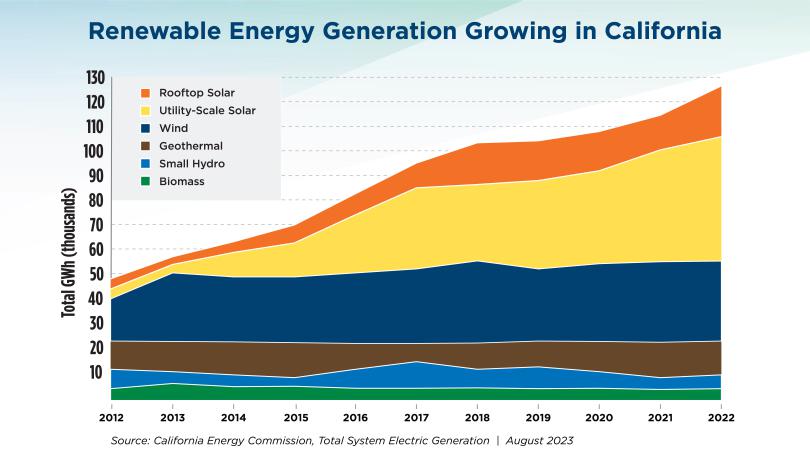
For Immediate Release: August 18, 2023
SACRAMENTO — Data from the California Energy Commission (CEC) highlight California’s continued progress toward building a more resilient grid, achieving 100 percent clean electricity and meeting the state’s carbon neutrality goals.
Analysis of the state’s Total System Electric Generation report shows how California’s power mix has changed over the last decade. Since 2012:
In addition to total utility generation, rooftop solar increased by 10 times generating 24,309 GWh of clean power in 2022. The state’s expanding fleet of battery storage resources also help support the grid by charging during the day using excess renewable power for use in the evening.
“ This latest report card showing how solar energy boomed as natural gas powered electricity experienced a steady 20 percent decline over the last decade is encouraging,” said CEC Vice Chair Siva Gunda . “Even as climate impacts become increasingly severe, California remains committed to transitioning away from polluting fossil fuels and delivering on the promise to build a future power grid that is clean, reliable and affordable.”

Senate Bill 100 (2018) requires 100 percent of California’s electric retail sales be supplied by renewable and zero-carbon energy sources by 2045. To keep the state on track, last year Governor Gavin Newsom signed SB 1020, establishing interim targets of 90 percent clean electricity by 2035 and 95 percent by 2040.
The state monitors progress through the Renewables Portfolio Standard (RPS) , which tracks the power mix of retail sales. The latest data show that in 2021 more than 37 percent of the state’s electricity came from RPS-eligible sources such as solar and wind, an increase of 2.7 percent compared to 2020. When combined with other sources of zero-carbon energy such as large hydroelectric generation and nuclear, nearly 59 percent of the state’s retail electricity sales came from nonfossil fuel sources.
The total system electric generation report is based on electric generation from all in-state power plants rated 1 megawatt (MW) or larger and imported utility-scale power generation. It reflects the percentage of a specific resource compared to all power generation, not just retail sales. T he total system electric generation report accounts for energy used for water conveyance and pumping, transmission and distribution losses and other uses not captured under RPS.
Progress Toward Clean Energy Continues Despite Impacts From Climate Change
The continued rise in renewables and decline in fossil fuel use come as the state experiences an unprecedented barrage of climate impacts, from heat waves to drought and wildfires.
In 2022, California experienced its eighth warmest and ninth driest year over the past 128 years. Temperatures in California have risen almost 3 degrees Fahrenheit since the beginning of the 20th century, and the six warmest years on record have all occurred since 2014, according to the National Oceanic and Atmospheric Administration.
In the past three years, unprecedented summer heat waves driven by climate change have put tremendous stress on California’s power grid, driving demand to new highs and creating a precarious situation for the ability of the power grid to meet additional demand. State energy forecasters predict these erratic and intense weather events will continue, creating a tight energy supply in the coming years until additional energy production is brought on-line.
To better equip the grid for the years ahead, Governor Gavin Newsom signed legislation in 2022 to create the Strategic Reliability Reserve. The reserve serves as a bulwark during grid emergencies and is an important tool in the energy transition. The reserve consists of demand response programs and other power resources that can be deployed in the event of an energy emergency.
The California Public Utilities Commission has ordered 18,800 MW of new clean resources to come on-line by 2028. Efforts are underway to foster the development of long-duration energy storage and offshore wind energy projects in the coming decades to continue diversifying and expanding the state’s clean energy portfolio.
About the California Energy Commission
The California Energy Commission is leading the state to a 100 percent clean energy future. It has seven core responsibilities: developing renewable energy, transforming transportation, increasing energy efficiency, investing in energy innovation, advancing state energy policy, certifying power plants and preparing for energy emergencies.